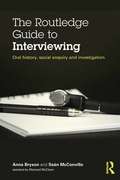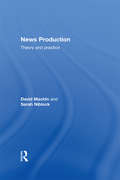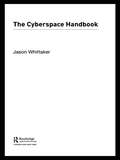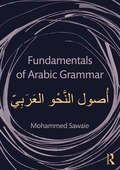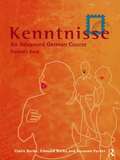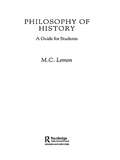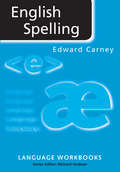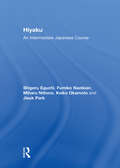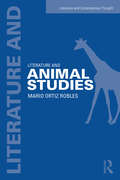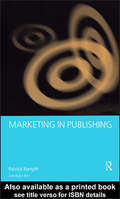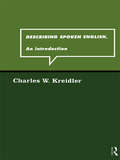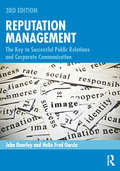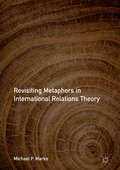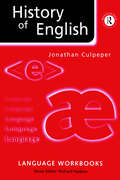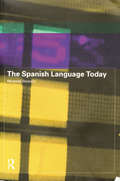- Table View
- List View
The Routledge Guide to Interviewing: Oral History, Social Enquiry and Investigation
by Sean McConville Anna BrysonThe Routledge Guide to Interviewing sets out a well-tested and practical approach and methodology: what works, difficulties and dangers to avoid and key questions which must be answered before you set out. Background methodological issues and arguments are considered and drawn upon but the focus is on what is ethical, legally acceptable and productive: Rationale (why, what for, where, how) Ethics and Legalities (informed consent, data protection, risks, embargoes) Resources (organisational, technical, intellectual) Preparation (selecting and approaching interviewees, background and biographical research, establishing credentials, identifying topics) Technique (developing expertise and confidence) Audio-visual interviews Analysis (modes, methods, difficulties) Storage (archiving and long-term preservation) Sharing Resources (dissemination and development) From death row to the mansion of a head of state, small kitchens and front parlours, to legislatures and presbyteries, Anna Bryson and Seán McConville’s wide interviewing experience has been condensed into this book. The material set out here has been acquired by trial, error and reflection over a period of more than four decades. The interviewees have ranged from the delightfully straightforward to the painfully difficult to the near impossible – with a sprinkling of those that were impossible. Successful interviewing draws on the survival skills of everyday life. This guide will help you to adapt, develop and apply these innate skills. Including a range of useful information such as sample waivers, internet resources, useful hints and checklists, it provides sound and plain-speaking support for the oral historian, social scientist and investigator.
News Production: Theory and Practice
by Sarah Niblock David MachinBringing to the forefront a much-needed book that bridges the gap between journalistic theory and practice, Sarah Niblock and David Machin provide here an invaluable real-life account of reporting in the context of contemporary newsrooms. Providing eight detailed ethnographies of eight different news production settings, News Production includes individual chapters that follow two news workers through their daily routines, detailing the exact nature of their jobs. It provides students with: case studies to compare to their own experiences concrete examples to consolidate their skill-based training questions to raise about their placements information on how to prepare reports constraints they may encounter, and how to deal with them. With chapters including ‘News Agencies’, ‘The Roving Reporter’, ‘Photojournalism’ and ‘The New Reporter Learning the Ropes’, for anyone taking practical units in news reporting, sub-editing, and law and ethics, News Production will provide them with all the information they need to succeed in this hectic, competitive and exciting world.
News Production: Theory and Practice
by Sarah Niblock David MachinBringing to the forefront a much-needed book that bridges the gap between journalistic theory and practice, Sarah Niblock and David Machin provide here an invaluable real-life account of reporting in the context of contemporary newsrooms. Providing eight detailed ethnographies of eight different news production settings, News Production includes individual chapters that follow two news workers through their daily routines, detailing the exact nature of their jobs. It provides students with: case studies to compare to their own experiences concrete examples to consolidate their skill-based training questions to raise about their placements information on how to prepare reports constraints they may encounter, and how to deal with them. With chapters including ‘News Agencies’, ‘The Roving Reporter’, ‘Photojournalism’ and ‘The New Reporter Learning the Ropes’, for anyone taking practical units in news reporting, sub-editing, and law and ethics, News Production will provide them with all the information they need to succeed in this hectic, competitive and exciting world.
The Cyberspace Handbook
by Jason WhittakerThe Cyberspace Handbook is a comprehensive guide to all aspects of new media, information technologies and the internet. It gives an overview of the economic, political, social and cultural contexts of cyberspace, and provides practical advice on using new technologies for research, communication and publication. The Cyberspace Handbook includes: *a glossary of over eighty key terms*a list of over ninety web resources for news and entertainment, new media and web development, education and reference, and internet and web information* specialist chapters on web design and journalism and writing on the web*Over thirty illustrations of internet material and software applications.Jason Whittaker explores how cyberspace has been constructed, how it is used and extends into areas as different as providing us immediate news or immersive games and virtual technologies for areas such as copyright and cybercrime, as well as key skills in employing the internet for research or writing and designing for the Web.
The Cyberspace Handbook
by Jason WhittakerThe Cyberspace Handbook is a comprehensive guide to all aspects of new media, information technologies and the internet. It gives an overview of the economic, political, social and cultural contexts of cyberspace, and provides practical advice on using new technologies for research, communication and publication. The Cyberspace Handbook includes: *a glossary of over eighty key terms*a list of over ninety web resources for news and entertainment, new media and web development, education and reference, and internet and web information* specialist chapters on web design and journalism and writing on the web*Over thirty illustrations of internet material and software applications.Jason Whittaker explores how cyberspace has been constructed, how it is used and extends into areas as different as providing us immediate news or immersive games and virtual technologies for areas such as copyright and cybercrime, as well as key skills in employing the internet for research or writing and designing for the Web.
Fundamentals of Arabic Grammar
by Mohammed SawaieFundamentals of Arabic Grammar provides an authoritative guide to Modern Standard Arabic (MSA) grammar. It has been organised to promote a thorough understanding of MSA grammar and presents its complexities in a cohesive and user-friendly format, filling many gaps left by other textbooks. Explanations are clear, full and accessible and extensive cross-referencing, two generous indices and six appendices provide users with easy access to the information they require. No prior knowledge of linguistic terminology is required. Features include: Expert treatment of a full range of grammar topics and structures, including the case system, Idhaafa, the equational sentence, quantifiers and the vocative, generously spread across thirty eight chapters Special attention to parts of speech, such as nouns, pronouns, adjectives, adverbs and propositions, given at the beginning of the book to acquaint students with the basic units of Arabic and provide a solid foundation for further learning A wide range of contemporary examples drawn from real life to provide solid context to grammar points, further supported by word glosses and idiomatic translations of sentences Grammatical terms given in both Arabic and English A wide variety of supplementary learning resources such as practice sheets, exercises and verb tables available for free download at http://www.routledge.com/books/details/9780415710046/ Substantial bibliography incorporating primary Arabic grammar sources in addition to secondary sources in Arabic and in English Fundamentals of Arabic Grammar has been field tested over a number of years and has been written by a highly experienced teacher of Arabic. It will be an essential resource for students and teachers of Arabic at all university levels and is suitable for use both as a companion reference text in Arabic language courses and as a standalone text in independent grammar classes.
Fundamentals of Arabic Grammar
by Mohammed SawaieFundamentals of Arabic Grammar provides an authoritative guide to Modern Standard Arabic (MSA) grammar. It has been organised to promote a thorough understanding of MSA grammar and presents its complexities in a cohesive and user-friendly format, filling many gaps left by other textbooks. Explanations are clear, full and accessible and extensive cross-referencing, two generous indices and six appendices provide users with easy access to the information they require. No prior knowledge of linguistic terminology is required. Features include: Expert treatment of a full range of grammar topics and structures, including the case system, Idhaafa, the equational sentence, quantifiers and the vocative, generously spread across thirty eight chapters Special attention to parts of speech, such as nouns, pronouns, adjectives, adverbs and propositions, given at the beginning of the book to acquaint students with the basic units of Arabic and provide a solid foundation for further learning A wide range of contemporary examples drawn from real life to provide solid context to grammar points, further supported by word glosses and idiomatic translations of sentences Grammatical terms given in both Arabic and English A wide variety of supplementary learning resources such as practice sheets, exercises and verb tables available for free download at http://www.routledge.com/books/details/9780415710046/ Substantial bibliography incorporating primary Arabic grammar sources in addition to secondary sources in Arabic and in English Fundamentals of Arabic Grammar has been field tested over a number of years and has been written by a highly experienced teacher of Arabic. It will be an essential resource for students and teachers of Arabic at all university levels and is suitable for use both as a companion reference text in Arabic language courses and as a standalone text in independent grammar classes.
Kenntnisse: Teacher's book
by Claire S. Burke Edmund Burke Susanne ParkerFirst published in 1999. Routledge is an imprint of Taylor & Francis, an informa company.
Kenntnisse: Teacher's book
by Claire S. Burke Edmund Burke Susanne ParkerFirst published in 1999. Routledge is an imprint of Taylor & Francis, an informa company.
Philosophy of History: A Guide for Students
by M. C. LemonPhilosophy of History is an essential introduction to a vast body of writing about history, from classical Greece and Rome to the modern world. M.C. Lemon maps out key debates and central concepts of philosophy of history, placing principal thinkers in the context of their times and schools of thought. Lemon explains the crucial differences between speculative philosophy as an enquiry into the content of history, and analytic philosophy of history as relating to the methods of history. The first two parts of the book trace each of these traditions, whereas the third part revisits both in the light of recent contributions to the discipline. This guide provides a comprehensive survey of historical thought since ancient times. Its clear terminology and lucid argument will make it an invaluable source for students and teachers alike.
Philosophy of History: A Guide for Students
by M. C. LemonPhilosophy of History is an essential introduction to a vast body of writing about history, from classical Greece and Rome to the modern world. M.C. Lemon maps out key debates and central concepts of philosophy of history, placing principal thinkers in the context of their times and schools of thought. Lemon explains the crucial differences between speculative philosophy as an enquiry into the content of history, and analytic philosophy of history as relating to the methods of history. The first two parts of the book trace each of these traditions, whereas the third part revisits both in the light of recent contributions to the discipline. This guide provides a comprehensive survey of historical thought since ancient times. Its clear terminology and lucid argument will make it an invaluable source for students and teachers alike.
English Spelling
by Edward CarneyEnglish Spelling explores the rules and conventions on which present-day English spelling is based.This Language Workbook:* Examines how speech-sounds map onto each other* Explores the extent to which words sound identical or look identical* Analyzes various kinds of spelling mistakes* Looks at the main differences between American and British spelling* Shows how and why the names of people and places may vary from expected spelling conventions* Deals with the punctuation of words by apostrophes, hyphens and capitalisation* Considers several possible approaches to spelling reform
English Spelling
by Edward CarneyEnglish Spelling explores the rules and conventions on which present-day English spelling is based.This Language Workbook:* Examines how speech-sounds map onto each other* Explores the extent to which words sound identical or look identical* Analyzes various kinds of spelling mistakes* Looks at the main differences between American and British spelling* Shows how and why the names of people and places may vary from expected spelling conventions* Deals with the punctuation of words by apostrophes, hyphens and capitalisation* Considers several possible approaches to spelling reform
Hiyaku: An Intermediate Japanese Course
by Shigeru Eguchi Fumiko Nazikian Miharu Nittono Keiko Okamoto Jisuk ParkHiyaku: An Intermediate Japanese Course provides a progressive intermediate course in Japanese, incorporating modern teaching methods and practicing all four language skills. Hiyaku provides content-based instruction, with authentic and semi-authentic dialogues and readings, all carefully selected to instruct and inspire students as they learn Japanese. Key features of the textbook include: highly structured chapters, beginning with warm-up exercises followed by focused practice of each of the four skills gradual introduction to increasingly authentic materials content taken from original Japanese sources such as books, TV programs, magazines, newspapers and websites extensive audio material provided as FREE MP3 files on a companion website instructor’s materials, including PowerPoint files provided through the companion website. Hiyaku does not simply teach language and basic cultural points: it also helps students gain a holistic understanding of Japanese society and history, and provides the necessary foundation for the advanced study of Japan and its language.
Hiyaku: An Intermediate Japanese Course
by Shigeru Eguchi Fumiko Nazikian Miharu Nittono Keiko Okamoto Jisuk ParkHiyaku: An Intermediate Japanese Course provides a progressive intermediate course in Japanese, incorporating modern teaching methods and practicing all four language skills. Hiyaku provides content-based instruction, with authentic and semi-authentic dialogues and readings, all carefully selected to instruct and inspire students as they learn Japanese. Key features of the textbook include: highly structured chapters, beginning with warm-up exercises followed by focused practice of each of the four skills gradual introduction to increasingly authentic materials content taken from original Japanese sources such as books, TV programs, magazines, newspapers and websites extensive audio material provided as FREE MP3 files on a companion website instructor’s materials, including PowerPoint files provided through the companion website. Hiyaku does not simply teach language and basic cultural points: it also helps students gain a holistic understanding of Japanese society and history, and provides the necessary foundation for the advanced study of Japan and its language.
Literature and Animal Studies (Literature and Contemporary Thought)
by Mario Ortiz-RoblesWhy do animals talk in literature? In this provocative book, Mario Ortiz Robles tracks the presence of animals across an expansive literary archive to argue that literature cannot be understood as a human endeavor apart from its capacity to represent animals. Focusing on the literary representation of familiar animals, including horses, dogs, cats, and songbirds, Ortiz Robles examines the various tropes literature has historically employed to give meaning to our fraught relations with other animals. Beyond allowing us to imagine the lives of non-humans, literature can make a lasting contribution to Animal Studies, an emerging discipline within the humanities, by showing us that there is something fictional about our relation to animals. Literature and Animal Studies combines a broad mapping of literary animals with detailed readings of key animal texts to offer a new way of organizing literary history that emphasizes genera over genres and a new way of classifying animals that is premised on tropes rather than taxa. The book makes us see animals and our relation to them with fresh eyes and, in doing so, prompts us to review the role of literature in a culture that considers it an endangered art form.
Marketing in Publishing
by Robin Birn Patrick ForsythMarketing in Publishing, offers a wealth of practical information on creative strategies to increase book sales in a competitive and rapidly-changing marketplace. It is the first comprehensive study in this area to be published since the ending of the Net Book Agreement.Patrick Forsyth, now a marketing consultant, draws in his many years' experience of the publishing industry to reinstate marketing firmly where it should be: as an integral and integrated part of the whole marketing process.Marketing in Publishing gives expert guidance on different elements of the marketing process, including advice on promotional and direct mail options, and a step-by-step section on how to make an effective sales call. It includes a valuable discussion of fusing market research intelligently to identify new opportunities and market niches. The book also features an authoritative chapter evaluating the importance of electronic publishing.Completely up-to-date, Marketing in Publishing will be essential reading both for those working in marketing and editorial departments, and for students of publishing studies.
Describing Spoken English: An Introduction
by Charles W. KreidlerDescribing Spoken English provides a practical and descriptive introduction to the pronunciation of contemporary English. It presumes no prior knowledge of phonetics and phonology.Charles Kreidler describes the principal varieties of English in the world today. Whilst concentrating on the phonological elements they share, the author sets out specific differences as minor variations on a theme. Although theoretically orientated towards generative phonology, theory is minimal and the book is clear, comprehensive and accessible to undergraduate and postgraduate students of linguistics and English Language. Numerous exercises are included to encourage further study.
Describing Spoken English: An Introduction
by Charles W. KreidlerDescribing Spoken English provides a practical and descriptive introduction to the pronunciation of contemporary English. It presumes no prior knowledge of phonetics and phonology.Charles Kreidler describes the principal varieties of English in the world today. Whilst concentrating on the phonological elements they share, the author sets out specific differences as minor variations on a theme. Although theoretically orientated towards generative phonology, theory is minimal and the book is clear, comprehensive and accessible to undergraduate and postgraduate students of linguistics and English Language. Numerous exercises are included to encourage further study.
Reputation Management: The Key to Successful Public Relations and Corporate Communication
by John Doorley Helio Fred GarciaReputation Management is a how-to guide for students and professionals, as well as CEOs and other business leaders. It rests on the premise that reputation can be measured, monitored, and managed. Organized by corporate communication units including media relations, employee communication, government relations, and investor relations, the book provides a field-tested guide to corporate reputation problems such as leaked memos, unfair treatment by the press, and negative rumors, and focuses on practical solutions. Each chapter is fleshed out with the real-world experience of the authors and contributors, who come from a wide range of professional corporate communication backgrounds. Updates to the third edition include: Global content has been incorporated and expanded throughout the book, rather than being restricted to only one chapter. Opening vignettes, examples, and case studies have been updated in each chapter. Additional case studies and examples with an international focus have been added.
Reputation Management: The Key to Successful Public Relations and Corporate Communication
by John Doorley Helio Fred GarciaReputation Management is a how-to guide for students and professionals, as well as CEOs and other business leaders. It rests on the premise that reputation can be measured, monitored, and managed. Organized by corporate communication units including media relations, employee communication, government relations, and investor relations, the book provides a field-tested guide to corporate reputation problems such as leaked memos, unfair treatment by the press, and negative rumors, and focuses on practical solutions. Each chapter is fleshed out with the real-world experience of the authors and contributors, who come from a wide range of professional corporate communication backgrounds. Updates to the third edition include: Global content has been incorporated and expanded throughout the book, rather than being restricted to only one chapter. Opening vignettes, examples, and case studies have been updated in each chapter. Additional case studies and examples with an international focus have been added.
Revisiting Metaphors in International Relations Theory
by Michael P. MarksThis book presents an analysis of how metaphors are essential elements in the study of international relations. It acknowledges the fact that theory and practice in international relations often rest on common metaphorical concepts which have implications for the ways people around the world pursue their lives. Because of the increased attention metaphors have received as integral elements in political discourse, there is a need to investigate metaphorical concepts that are not neutral in their implications for understanding international relations. Inasmuch as government policy is shaped by metaphorical concepts that originate in the academic realm, and given that scholarly works are therefore partially involved in inspiring policy, the author subjects a range of metaphors in international relations theory to critical interrogation.
Revisiting Metaphors in International Relations Theory
by Michael P. MarksThis book presents an analysis of how metaphors are essential elements in the study of international relations. It acknowledges the fact that theory and practice in international relations often rest on common metaphorical concepts which have implications for the ways people around the world pursue their lives. Because of the increased attention metaphors have received as integral elements in political discourse, there is a need to investigate metaphorical concepts that are not neutral in their implications for understanding international relations. Inasmuch as government policy is shaped by metaphorical concepts that originate in the academic realm, and given that scholarly works are therefore partially involved in inspiring policy, the author subjects a range of metaphors in international relations theory to critical interrogation.
History of English
by Jonathan CulpeperHistory of English: * covers the development of the English language from the 5th century to the present day* contains a `mini-corpus' of texts, used for exercises and to illustrate points raised in the commentary* introduces key linguistic concepts* provides `discussion points' to generate debate* involves readers in collecting and analysing their own data
The Spanish Language Today
by Miranda StewartThe Spanish Language Today describes the varied and changing Spanish language at the end of the twentieth century. Suitable for introductory level upward, this book examines:* where Spanish is spoken on a global scale* the status of Spanish within the realms of politics, education and media* the standardisation of Spanish* specific areas of linguistic variation and change* how other languages and dialects spoken in the same areas affect the Spanish language* whether new technologies are an opportunity or a threat to the Spanish language.The Spanish Language Today contains numerous extracts from contemporary press and literary sources, a glossary of technical terms and selected translations.
